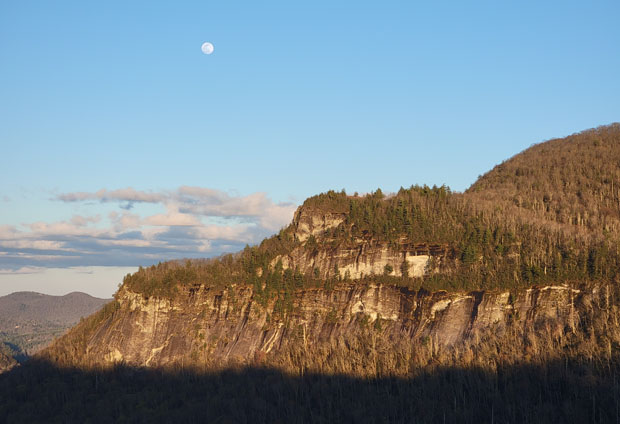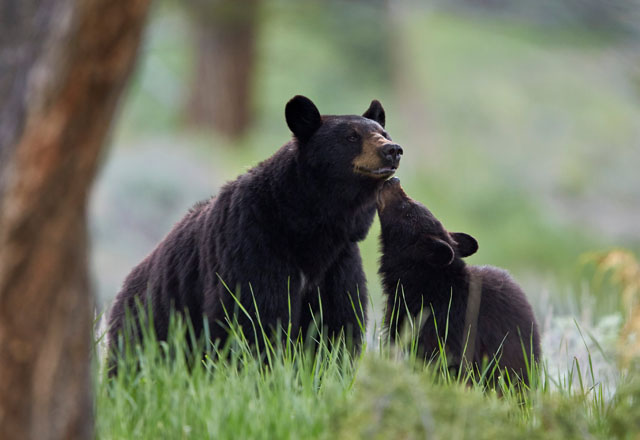Old Moon, Old Mountains
02 Feb 2023
Reflections on the Winter Moon
Story by KRISTIN LANDFIELD
Photos by ANDREW RENFRO

The moon was but a chin of gold
A night or two ago,
And now she turns her perfect face
Upon the world below.
-Emily Dickinson
When I think of a full moon, I first think of a cold crisp night in a stark winter landscape, dry and clear, where the glow from the celestial body illuminates silhouettes of naked trees. I want to bundle up and walk through the moon-washed woods, hushed in hibernation, so the crunch of my careful steps is the only sound other than a calling owl or the wind moving through bare branches.
There are few places east of the Rockies where the drama of the night sky is as arresting as in the Southern Appalachians. A proud moon rises over this big landscape with prominence, outshining (outglowing, really) any other object in the night sky. Here in the mountains, there is less ambient light from cities to compete with the cosmos, and higher elevation means thinner air through which to view them. On the Highlands-Cashiers Plateau, the striking beauty of the natural landscape is always on display: big vistas, rugged boulders, ample streams, waterfalls and verdant woods. When the lush vegetation of the greener months is dormant, these big vistas become more evident, and in winter, opposite a low sun, the full moon sits high in a panoramic sky. On such cold long nights, barren contours of the brumal landscape glow in the soft cast of earth’s moon. Its shimmering reflection engages an inner reflection that has ignited the human imagination throughout history.
It's not only a full moon that presides with prominence over these mountains; the crescent and gibbous moons, waxing then waning, hang beautifully in the night sky. Adjacent to the hulking mass of Whiteside Mountain or Chimney Rock, the ever-changing moon is luminous throughout its 29.5-day cycle. Relative positions of the sun, the moon and the earth give rise to the phases of the moon. The moon produces no light of its own, so what we see is the sun’s reflection from different angles as we rotate around our star. A small amount of light from distant stars and from earth (known as earthshine) illuminate the orb when we view the “dark side of the moon” that faces away from the sun. Because the phases of the moon renew every 29.5 days, there is a rare thirteenth moon in a 12-month year—known as a “blue moon”—once every 2.6 years. In 2023 there will be two moons in August, with the second “blue moon” being a supermoon as well.
The 12 full moons in the lunar calendar have been given names adopted from Native American, Celtic, Saxon and other ancient teachings. February’s is known as the Snow Moon or the Hungry Moon. The upcoming full moon in March will be the Worm Moon, when the ground begins to thaw, and the soil becomes ready for seeds. According to the Cherokee, the March moon is the Wind Moon, likewise preparing the land for spring. In the Appalachians, folk wisdom and superstition around the moon emerge in rural customs. Scotch-Irish lore that mingled with Cherokee traditions and early settlers’ observations has been passed down for generations in western North Carolina. Much of this advice is related to farming and is delineated in the Foxfire books — the best time within the lunar calendar to plant, to harvest, to can and store, to cut and dry timber and hay, when to expect rain, snow, etc. The prominent moon we see governing these mountain ranges wasn’t only a thing of inscrutable beauty, it was an essential guide for daily living.
The moon is said to symbolize the constancy of change and rebirth—mutability—yet there is something soothing about the regularity of the moon’s cycle. In nearly every culture, the moon holds special standing in mythology, tradition, folklore and ceremony. It represents wisdom, intuition, femininity and renewal, and casts a sense of mystery within its glow. We revere it. Still somehow, as our closest neighbor, it doesn’t seem fully indifferent to our mortal plight. In its habitual pattern of slivers, crescents and orbs, the moon draws down the cosmos to the oceans and governs the tides. Its mass stabilizes the earth on its axis while it revolves in a timeless dance with our own planet. This enduring recurrence of the moon’s phases resonates throughout the changing seasons of life. It’s hard to fathom how concepts as abstract as planetary rotation, the laws of gravity, or reflected starlight could simply be the wise old moon we humbly watch with the advancing of our days. Its allure is unending.














